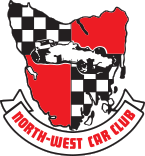History of Hellyer Rally
25 Years of the Hellyer Rally
By the early 1990s the car Club had not held a state championship rally for around six years. Lee Marshall and Stef Peters believed the time was right for the Club to once again conduct a major rally. In hindsight it was probably a tough time to do so as group G had recently been banned and PRC cars were the only cars eligible for state events. This was another classic CAMS short sighted decision which left many cars in the state unable to compete at the highest level, however by picking the best roads available, Leroy and Stef hoped to attract enough entries to make the event viable. The roads chosen were behind the gates at Hampshire and then on to the legendary Hellyer Gorge thus giving the event its name.
So for that first rally in 1991 a healthy entry of 14 crews were received but atrocious weather on the day with heavy wind and rain made the event very difficult for crews, officials and the organisers. All but two competitors finished the event which was pretty good considering the conditions, with Les Walkden and Ron Coenen taking a dominant win in the group A Galant VR 4. This was the car that George Fury had used to win a couple of rounds of the Australian Rally Championship in 1990 which Les then bought and he and Ron used it to dominate Tasmanian rallying in the early 1990s.
There were a few interesting names and cars entered in that first event such as the 240Z that finished second. After changing hands a couple of times it became a tarmac only car. Yes, that’s right, it is now Hodgo’s red rocket. There was a couple of blokes doing their first state round and both driving Mazdas RX 4’s. Lynn Rattray finished a solid 10th in his first Hellyer rally and hasn’t missed too many in the following 25 years. Dean Howard was a DNF in the ex Lee Walters RX 4 with his mate Kent Bedford beside him, and of course the reason for the DNF couldn’t have been the super navigators fault! What about the 180B that also DNF’d? Yes, that now belongs to yours truly.
After only receiving 12 entries in 1992, the Club pushed hard to be allowed to run a Club rally behind the main event. As the Club rally series was starting to prosper at this time it made sense to do this as Club competitors could cross enter into the state round, boosting numbers for the State event. Common sense prevailed and for 1993 a much more healthy 25 crews started the combined event. This was the start of a golden period for the Hellyer Rally with 30 or more competitors was not uncommon right through to the late 1990s.
A highlight of those early years was the various super special or spectator stages. The Waratah street stage which was formerly used by Rally Tasmania in the 1980s, was popular with both spectators and crews. Gravel tyres and suspension created extremes of understeer and oversteer making for spectacular action. I can recall Don Stevens in the plum Datsun 240 K spinning multiple times, some planned but most not! Lee Marshall certainly remembers the stage well, clipping a culvert in Stumpy 2 (RX 3) and ending upside down in the middle of the road. Stumpy 3 was then required! Some crews didn’t even make it to Waratah! Another great spectator stage was through the Oldina picnic ground with some crews managing to get lost amongst the trees and picnic tables. Navigating never was my strong point! There was also the West Park super special held in the gravel car park on the northern side of the oval. The stage always attracted large numbers of Saturday morning shoppers to come and check out what was making the huge dust cloud! Stages like this really helped to bring rallying to the people boosting the sport’s popularity.
The rally has had its highs and lows over the years with the biggest low coming in 2001 when torrential rain, not unlike what we have had recently, washed away the bridge over the Hellyer River on Blackwells Road. The classic Hellyer Gorge stages were now unusable and the rally had to change to survive. For those of us lucky enough to have rallied on these roads it was a sad day as the stages were unique to the state, being extremely twisty and rarely flat. An added bonus was that 100km of stages could easily be used with only a handful of officials needed. Sadly, Saxons, Parawee Creek and Blackwells Roads have now succumbed to nature and passed into rallying folklore. Since that time the rally has moved a number of times from Hampshire to West Takone and in recent years has been held on the fast, flowing and cresty roads of the Mawbanna area.
The Rally would not have been possible without our event directors, officials, sponsors and of course, competitors. Lee Marshall, Stef Peters, Balt Vandenberg, Eric flight, Peter Barrett and Mitch Roberts have kept the event going through the years as event directors. A lot of work goes into a rally of this magnitude so their efforts in keeping the event going should be recognized. Thanks to our sponsors the Rally has always been financially viable and some have been involved for many, many years. Up to 50 or more officials are needed to conduct this Rally which more often than not sees them standing out in rain and cold to make the event happen. Competitor numbers have fluctuated over the years but the event always bounces back eventually. Recent years has seen strong entries with even mainland competitors coming down to try the great roads and organization.
A rally would be nothing without competition and there has been some great battles over the years and some keen rivalry. There has always been a number of contenders fighting for the outright win, which of course would help them greatly in their pursuit of the Tasmanian championship. In the late 1990s we had a great rivalry between Lynn Rattray, Andrew Murfet and Mick Luscombe, and a few years later we had the Vandenbergs, Craig Brooks and David Waldon again battling it out with Lynn Rattray. There has also been some popular against the odds wins as well such as Peter Barrett taking the win in 1996, one of only two wins for two wheel drives in the rally’s history, the other being Lee Peterson in 1992. Eddie Maguire popped up for a surprise win in 2008 becoming the youngest winner of the rally. Of course there has been the hard luck stories as well, those that, with a little more luck could have made the results look a lot different, but of course that is rallying. With a little more luck in 2012 Kade Barrett might just have won, in his two wheel drive Plymouth Fire Arrow, after setting some stunning times to lead the rally.
After the death of local navigator Victor Huddleston in 1999 the Club awarded the outright winner of the Hellyer Rally a cup named in his honour. The most successful competitor in the events history is Lynn Rattray with six wins to his name. It took Lynn nine attempts before he broke through for his first win but he became a consistent winner from there on. Simon Vandenberg has taken the most wins for a navigator with five. Of course there are competitors who are keen to beat these records and write their own names in the record books by having their name “on the cup”
I’m sure there will be many more great battles in the years to come, not only out the front, but right through the field. More importantly, people will compete for the great roads, for the camaraderie of the rally fraternity, the prestige of the event and just for the adrenaline rush of driving flat out down a gravel road.

